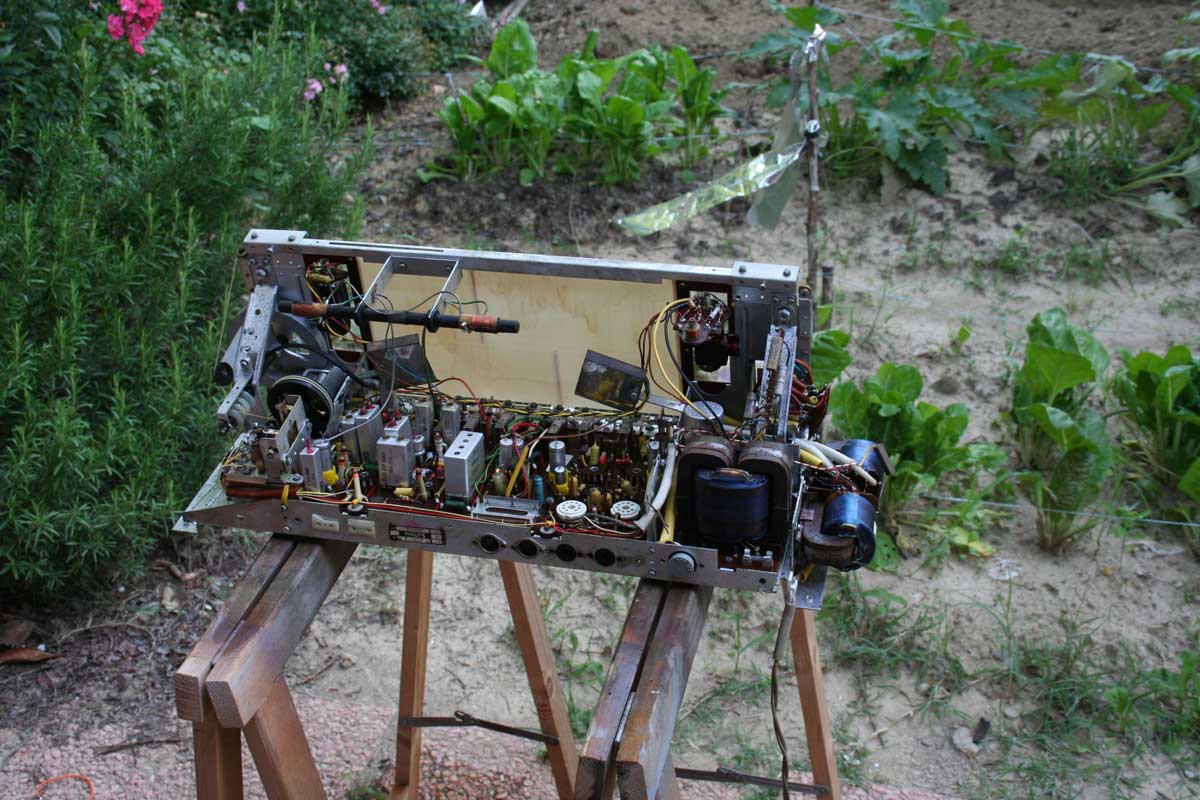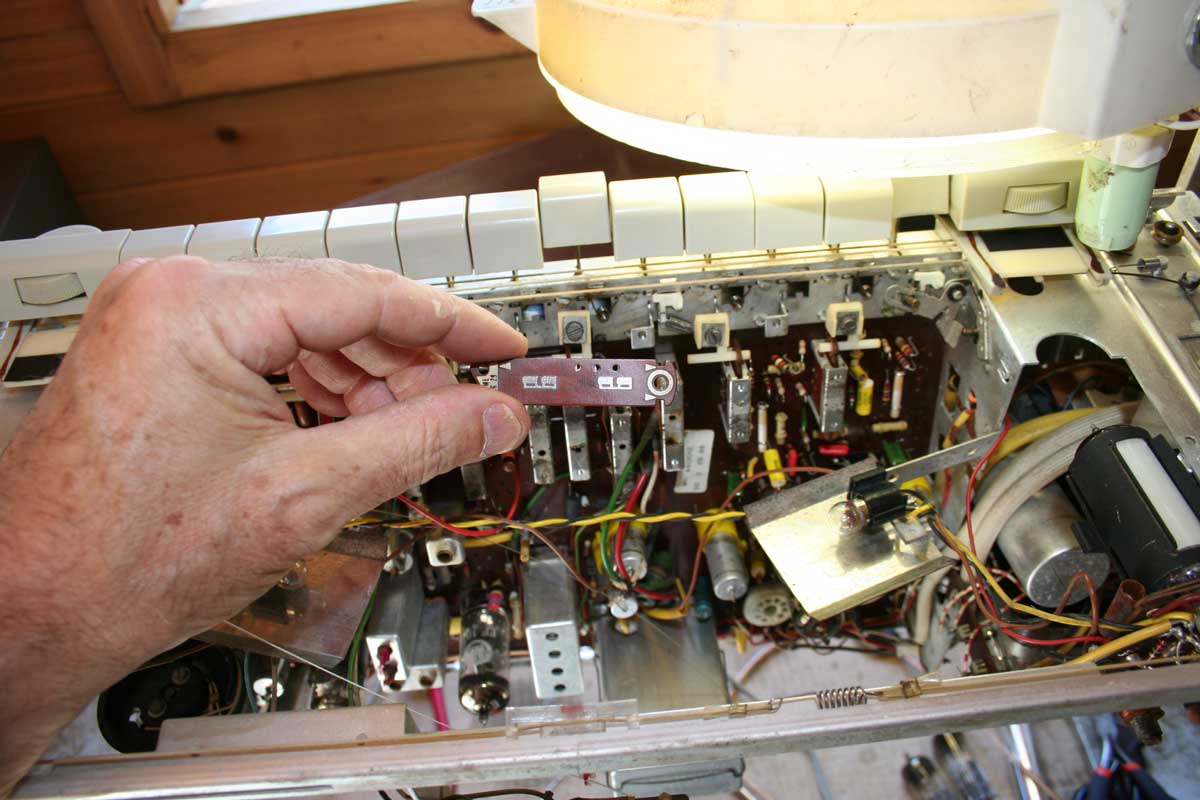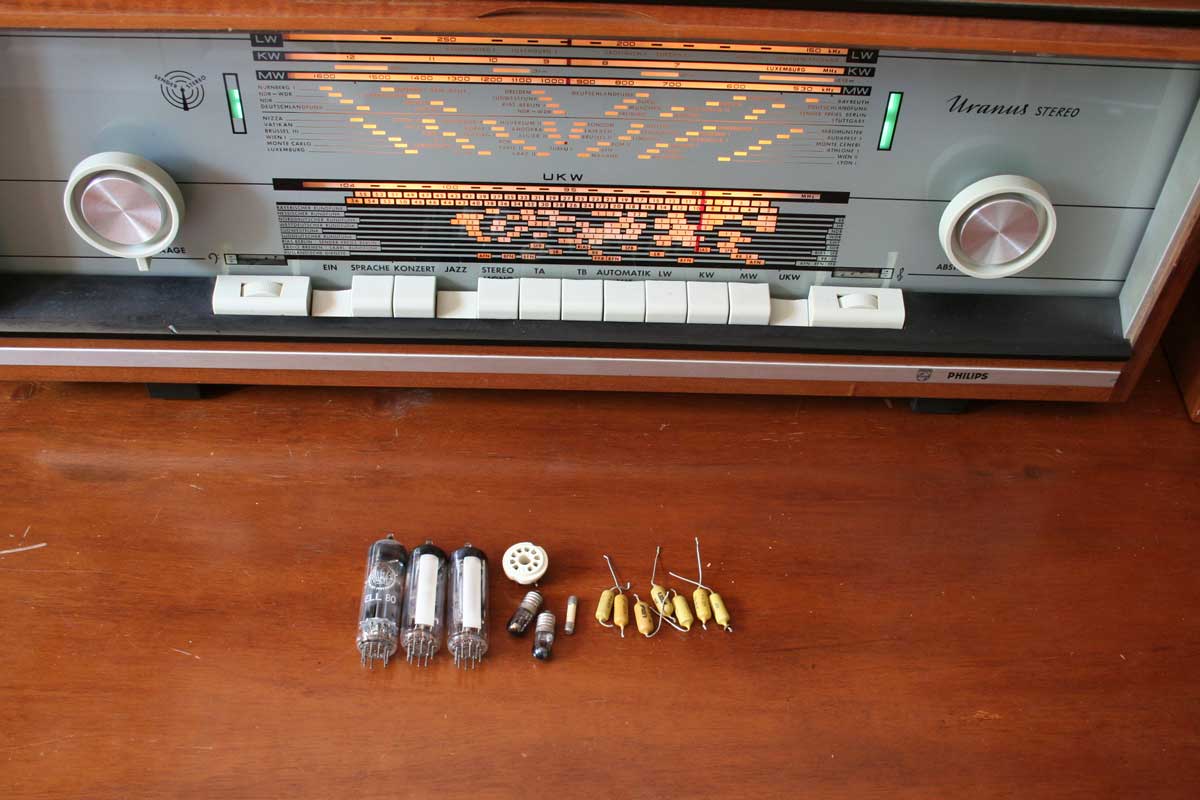 uncategorised - en
uncategorised - en
 uncategorised - en
uncategorised - en
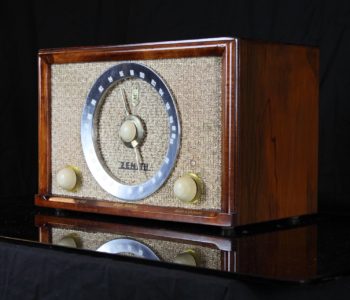 uncategorised - en
uncategorised - en
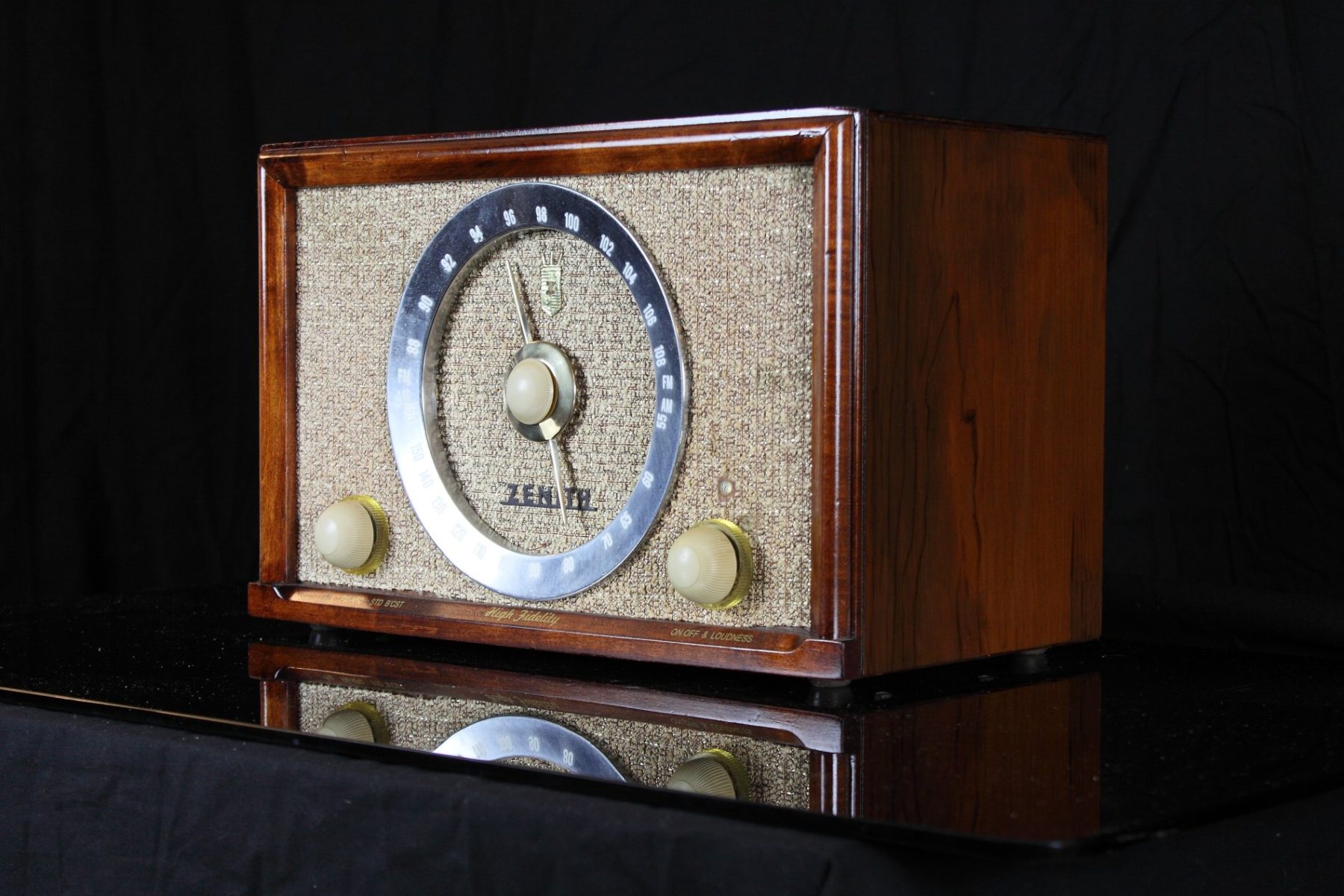





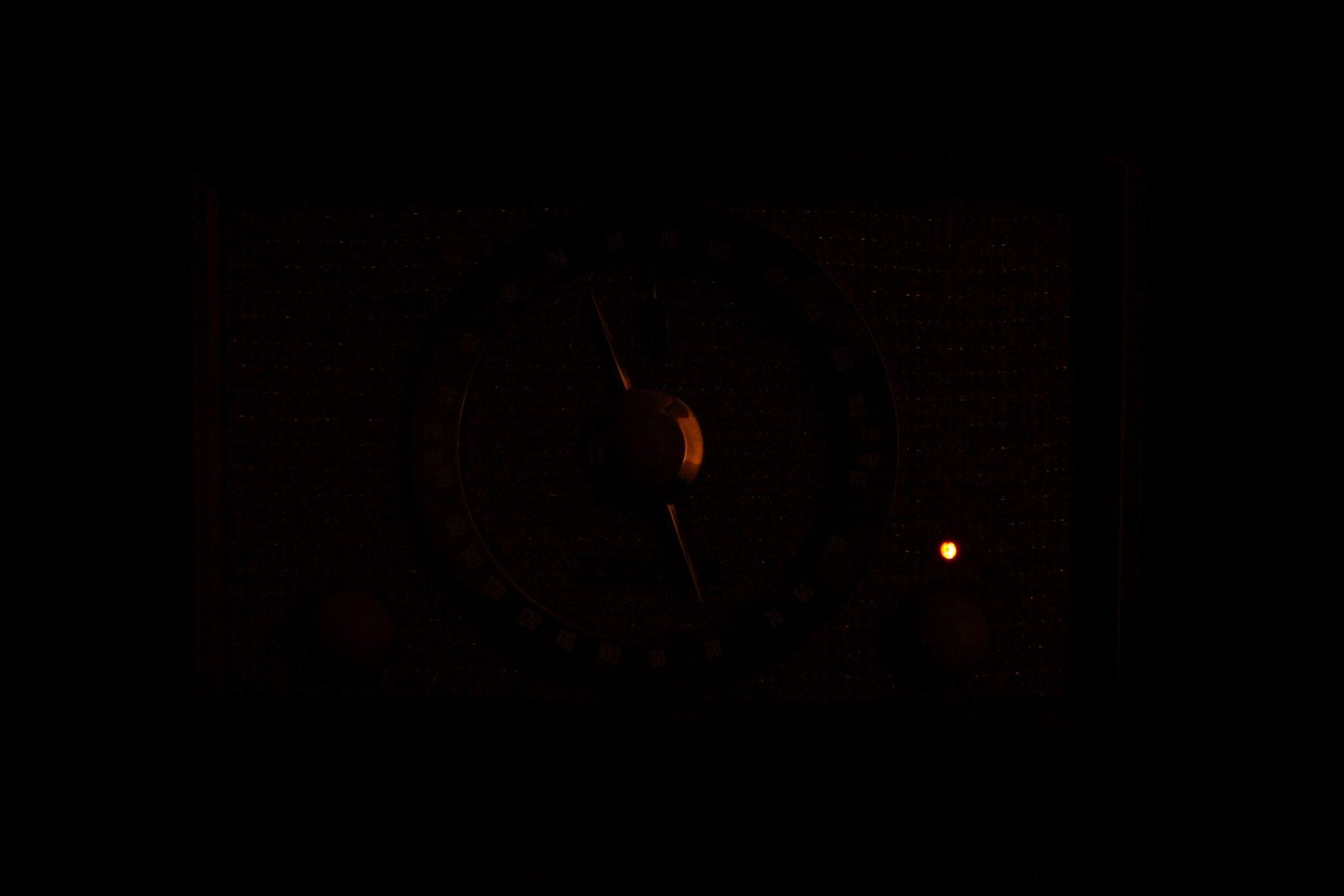
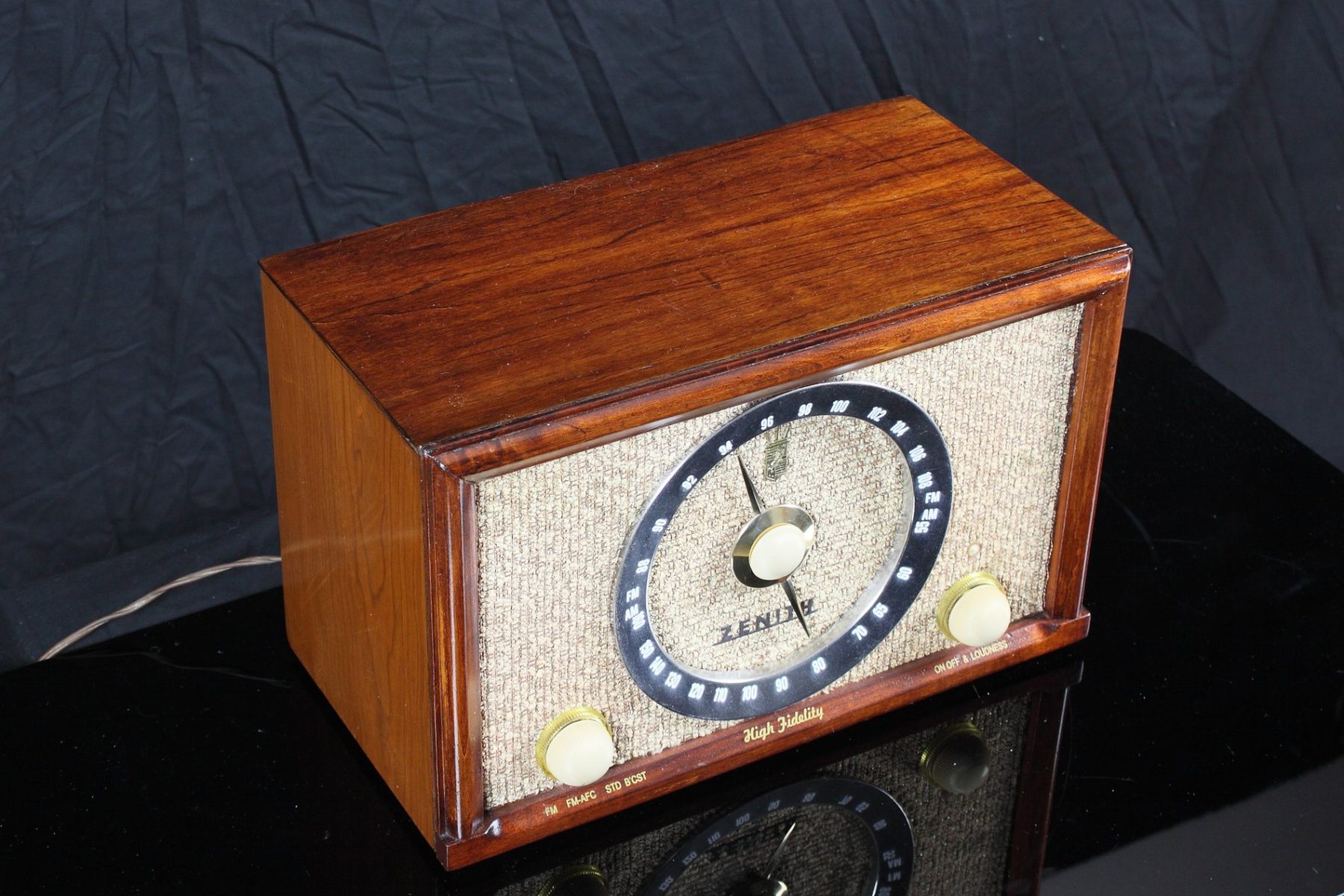




Produced in 1956 in Illinois (USA), the ZENITH B835R is a radio with very interesting features.
First of all, the cabinet is made of wood. This grants the device a quite extended tone quality.
Most of the devices produced in the USA in those years made extensive use of different plastics or agglomerates. This allowed to produce devices with very modern and creative shapes and designs. Nevertheless, none of these solutions gives a musicality similar to that of devices with wooden cabinets.
The loudspeaker is large for the device. These two details together ensure a musicality I have rarely found in small American devices.
Reception is good, both in AM and FM.
The tuner is equipped with AFC (Automatic Frequency Control) so FM reception is very stable.
The AFC must be excluded during the station search phase, otherwise the device automatically tunes only in the strongest stations.
Once the favorite station is tuned, the AFC can be insterted so that the tuned station remains stable.
The tuning has a step-down system and the two pointers are large and clearly visible, so the tuning is rather precise.
Another interesting feature of the ZENITH B835R is that in the rear there is an RCA socket for the Phono input.
A small switch is placed next to it and allows to choose whether to listen to the signal coming from the radio or the Phono input.
A turntable with piezo cartridge or other devices that provide similar output voltage can be connected to this input.
Basically, a device of modest dimensions but very enjoyable, versatile and pleasant.
This device is originally powered by 120 volts, so a special adapter is provided for countries that use different line voltages.
The whole playlist is dedicated to the USA, and in particular to the songs, original or interpreted, that this device ... probably knows already.
The first track I propose in the playlist is one of Mister Jazz's most famous songs, as Duke Ellington called him, I'm talking about Louis Armstrong.
Louis was born in a wooden shack in the very poor negro neighborhood of New Orleans. As a child, he is abandoned by his father and grows up on the streets.
He learns to play in a house of correction for negroes, after being arrested for shooting a friend on New Year's Eve of 1913.
After a tiring but successful life, after working on some films, including Paris blues in 1963, he brings to success Hello Dolly!, written by Jerry Herman for the musical of the same name.
In the musical, Dolly Gallagher is an ambitious and beautiful lady who arranges marriages and does business in the New York of the early 900s. The track accompanies the scene in which Dolly arrives at the Harmonia Gardens Rudolph, welcomed with honors by the restaurant staff.
It follows a classic certainly known by everyone, “Oh happy day”, which interpreted by the queen of Soul Music, Aretha Franklin, is really something else.
Soul Music, the real meaning of which is not “Music of the Soul”, simply “Spiritual Music”, but rather “Music of a typically black spirituality”. A spirituality which continuously alternates states of joy with states of emotion. A spirituality that united the Soul Sisters (in this case) in a fate determined by the color of their skin. For example the lyrics of the song played by Aretha say:
Oh happy day ... When Jesus washed ... He washed my sins away.
He taught me how to watch, fight and pray ... and live rejoicing everyday
In the playlist, famous songs by B.B.King, Johnny Cash and Withney Houston follow.
Bluetooth receiver embed
Each radio is equipped with a cable for connection to any digital device.
- Bluetooth receiver embed - The unit is equipped with a BLUETOOTH receiver powered directly by the receiver power supply. This makes it possible to control the amplifier from any external digital device as an IPAD, a Smartphone, or a sophisticated multimedia station. So you can hear your preferred web station or your lossesless file without cables on the room. Wireless Receiver can be equipped upon requests.
- Multi Platform Connection - A customized adaptation cable to connect any digital device as Iphone, Smartphone, Laptop, CD Player etc. will be provided with this radio. This special cable suits the different impedances between the modern equipment and the receiver. Furthermore the two stereo channels flow into one without increasing the load to the input unit.
The company known today as Zenith was founded in Chicago in 1918 by Karl Hassel and Ralph H. G. Mathews.
The original name “Z-Nith.” derived from the call letters of the founders’ amateur radio station, 9ZN.
In 1921, was moved into a 3,000-square-foot factory in Chicago.
In 1922, the company production rise between five radios each week to 50 per week. With the money of Eugene F. McDonald, Jr., Hassel and Mathews founded the Zenith Radio Corporation in 1923.
Zenith released the first portable radio in 1924.
In 1926 it released the first radio that operated entirely on household electricity.
Zenith became a leader in other consumer electronics developments, such as the first all-electronic TV station (1939), the first FM radio station in the Midwest (1940) and the world’s first subscription TV system.
With the coming of the Depression, Zenith was forced to change its focus from high-quality radios to more affordable ones.
During World War II, Zenith made bomb fuses and other devices for the government.
In 1955 Zenith released the first wireless remotes for TV.
In 1970 competitive pressures led Zenith entered the original equipment manufacturer (OEM) components and cable television products businesses.
In 1988, Zenith has been a leader in HDTV technologies.
In 1995, LG Electronics Inc. acquired a majority interest in Zenith.
In 1999, Zenith became a wholly owned subsidiary of LG.
Year of production: 1956
Superheterodyne IF: 455/10700
3 AM Circuits
7 FM Circuits
Wavebands:
(MW) 535 to 1620KHz
(FM) 88 to 108MHz
Loudspeakers
Wideband loudspeaker
Dimensions (LHD): 406 x 254 x 203 mm/16 x 10 x 8 inch
Net weight: 6.810 kg / 15 lb
Tubes 8:
12AU6 19T8 12BA6 12BA6 12AT7 6BJ6 6AB4 35C5

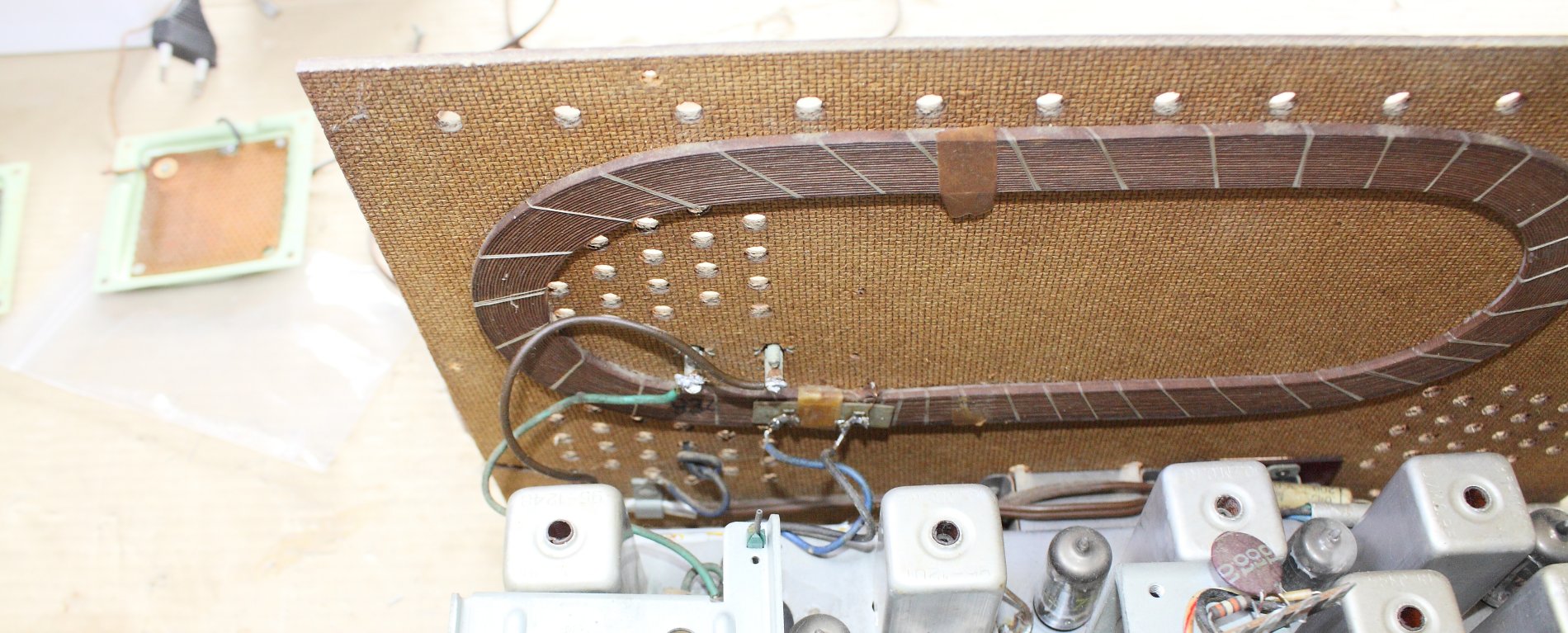
This device uses a loaded antenna on the rear panel.
It's sufficiently efficient but extremely directive, so the position of the radio impact on the quality of reception.
The back panel is prepared to connect an external antenna.
In this case the reception would be perfect.
The controls, as usual on the American radios, are reduced to the essential elements.
The light knob on the left is the band switch.
It has three positions:
FM without AFC (Automatic Frequency Control)
FM with AFC (Automatic Frequency Control)
Medium Waves (Standard Broadcast)
The coaxial golden knob controls the tuning.
The right knob is the power switch and volume control.
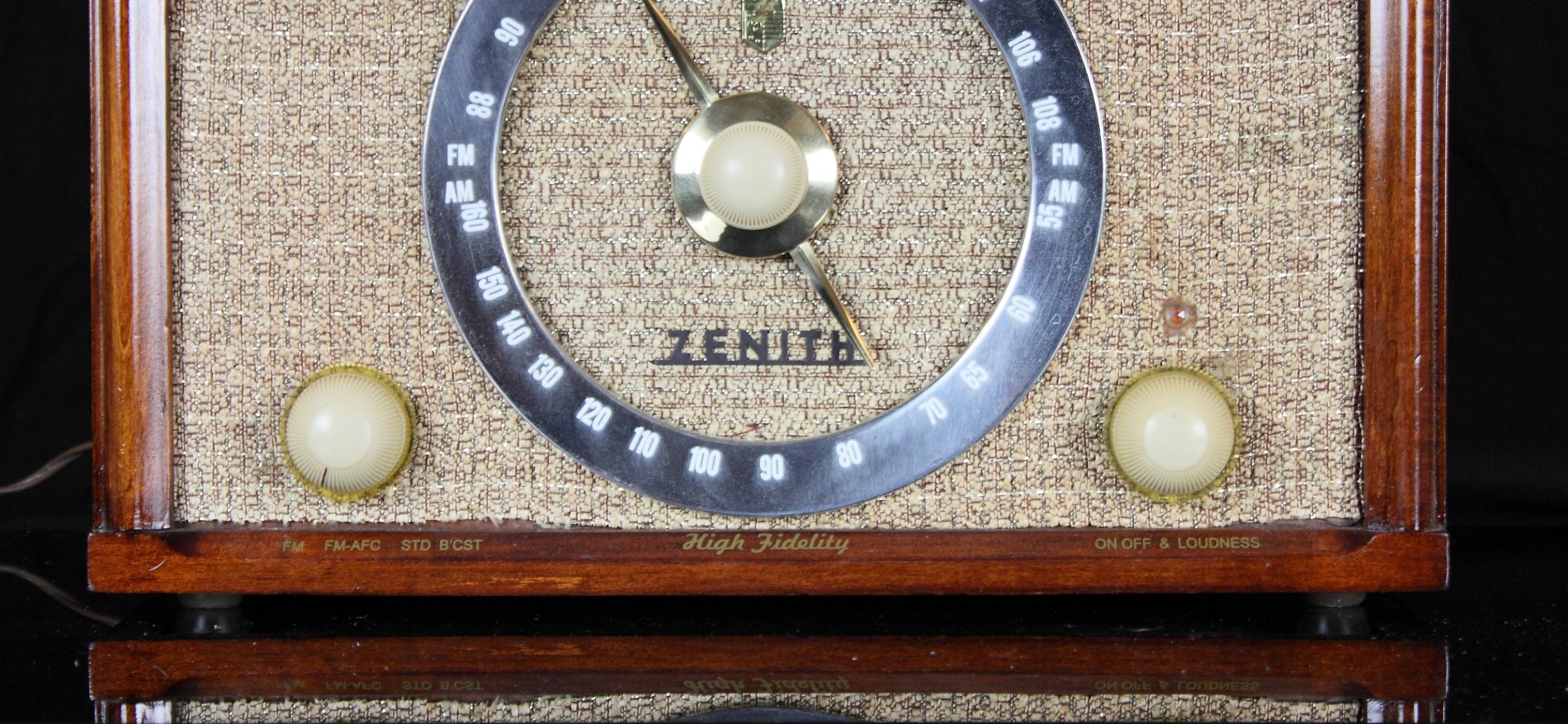
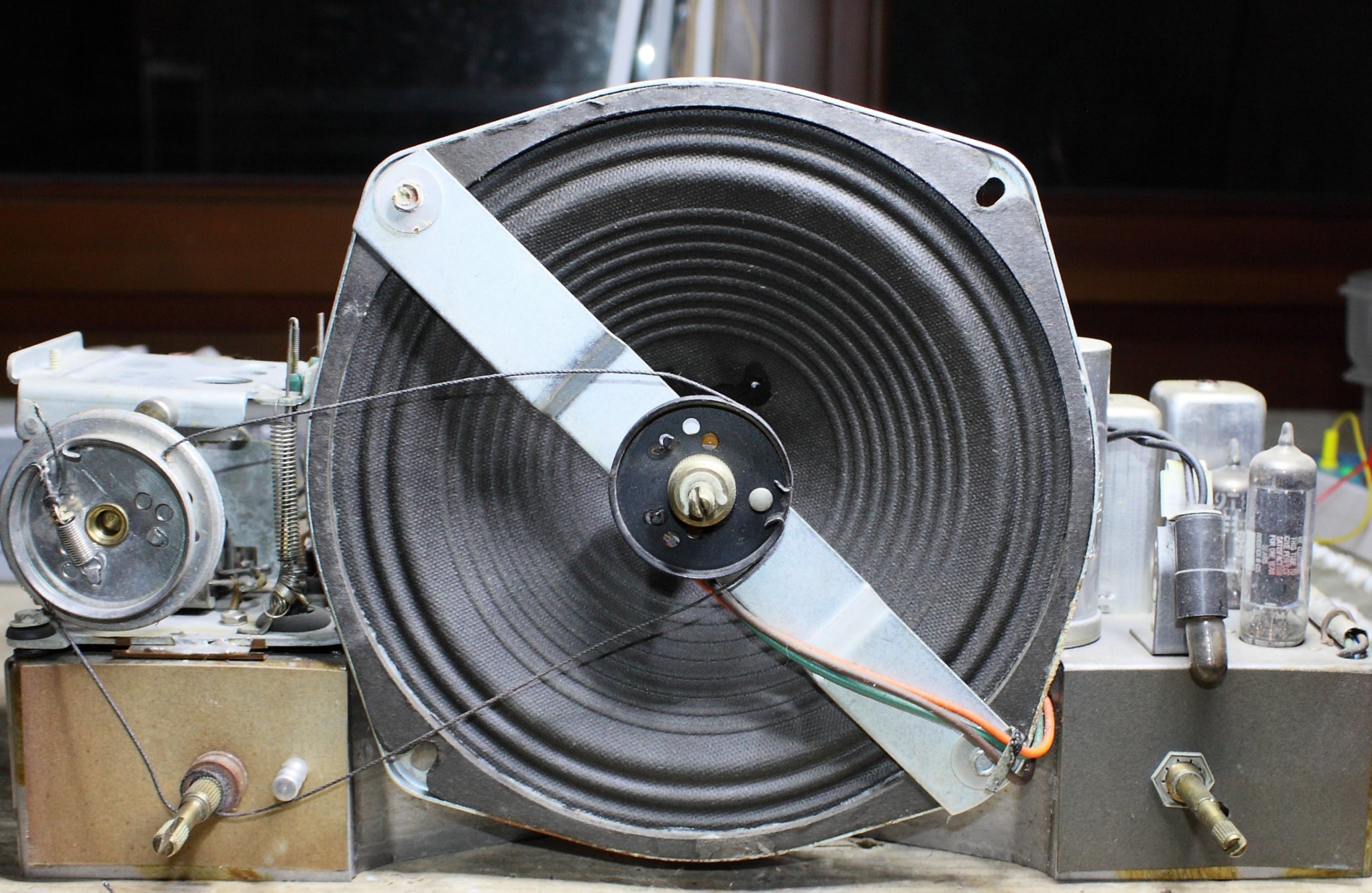
A 14 cm, very performing loudspeaker and two electrostatic loudspeakers were used.
The audio spectrum for FM broadcasts is sufficiently reproduced.
Of course, the deep bass and brilliant treble of the radios with 4 or 6 loudspeakers are missing, but the reproduction, enhanced by the wooden cabinet, is very pleasant and balanced.
On the rear side, the Radio / Phono switch is very interesting.
It is used to switch the listening from the radio to that of the Phono input.
RCA socket for the Phono input.
Classic inputs for antenna and for the ground.
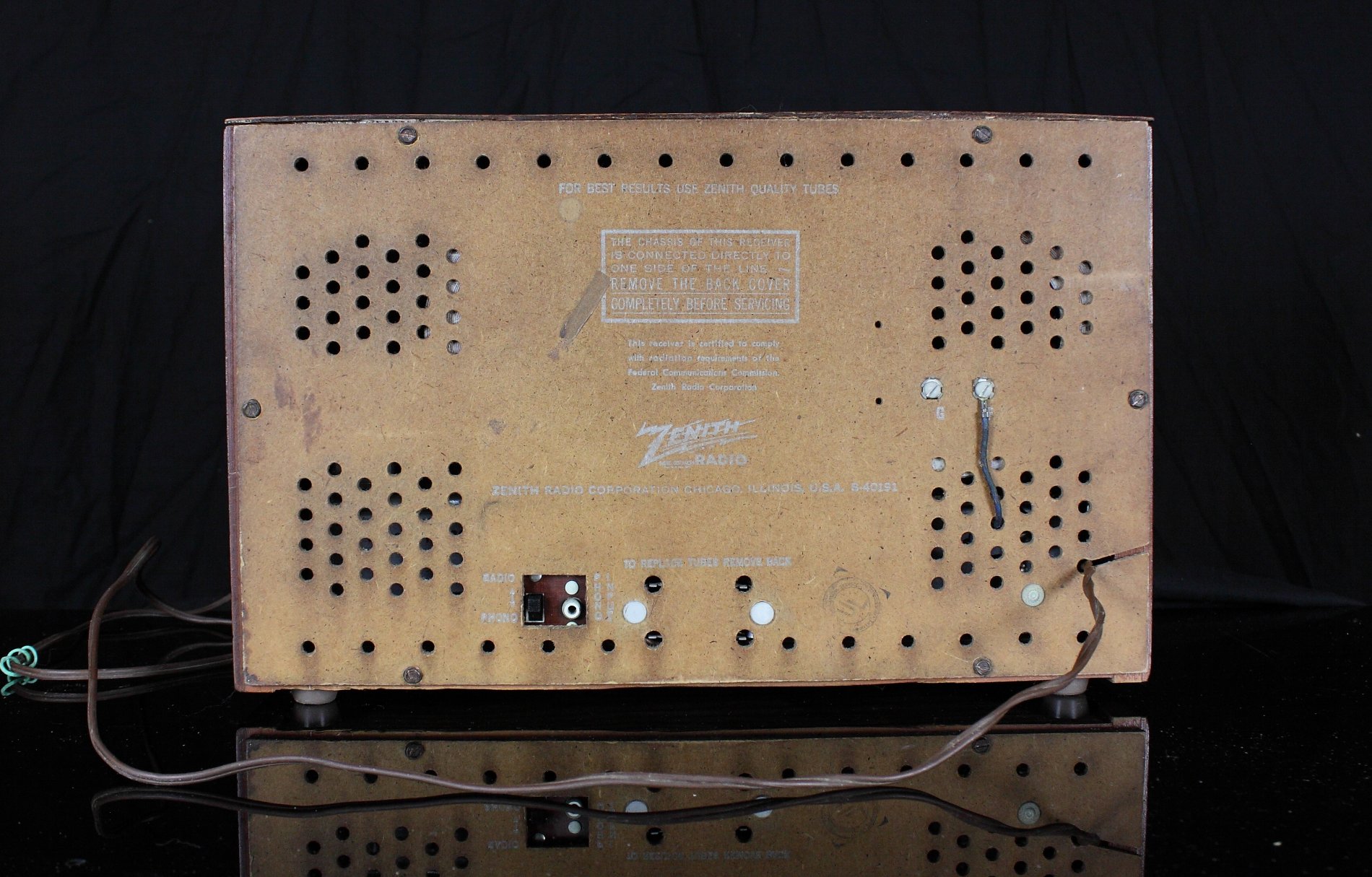
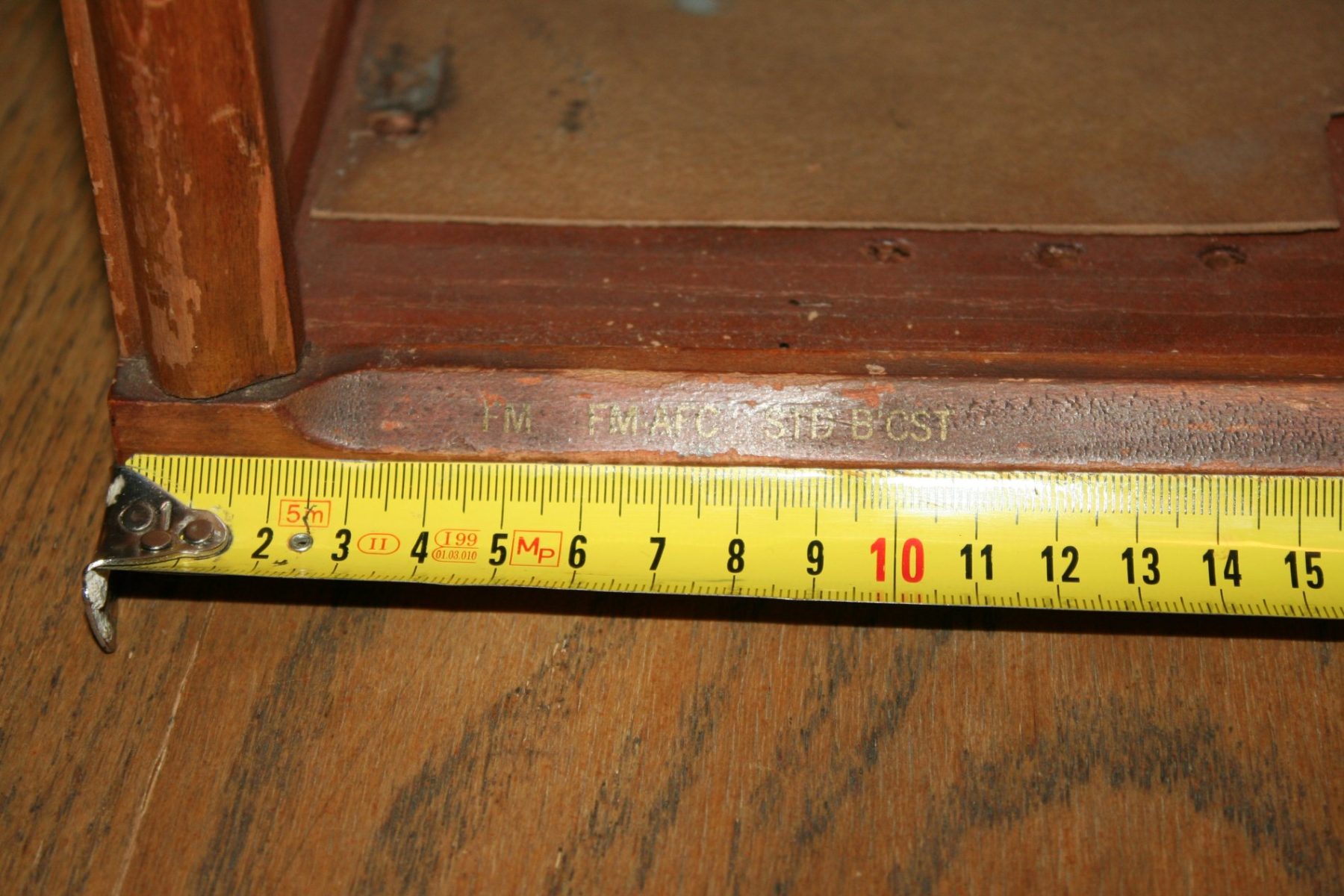

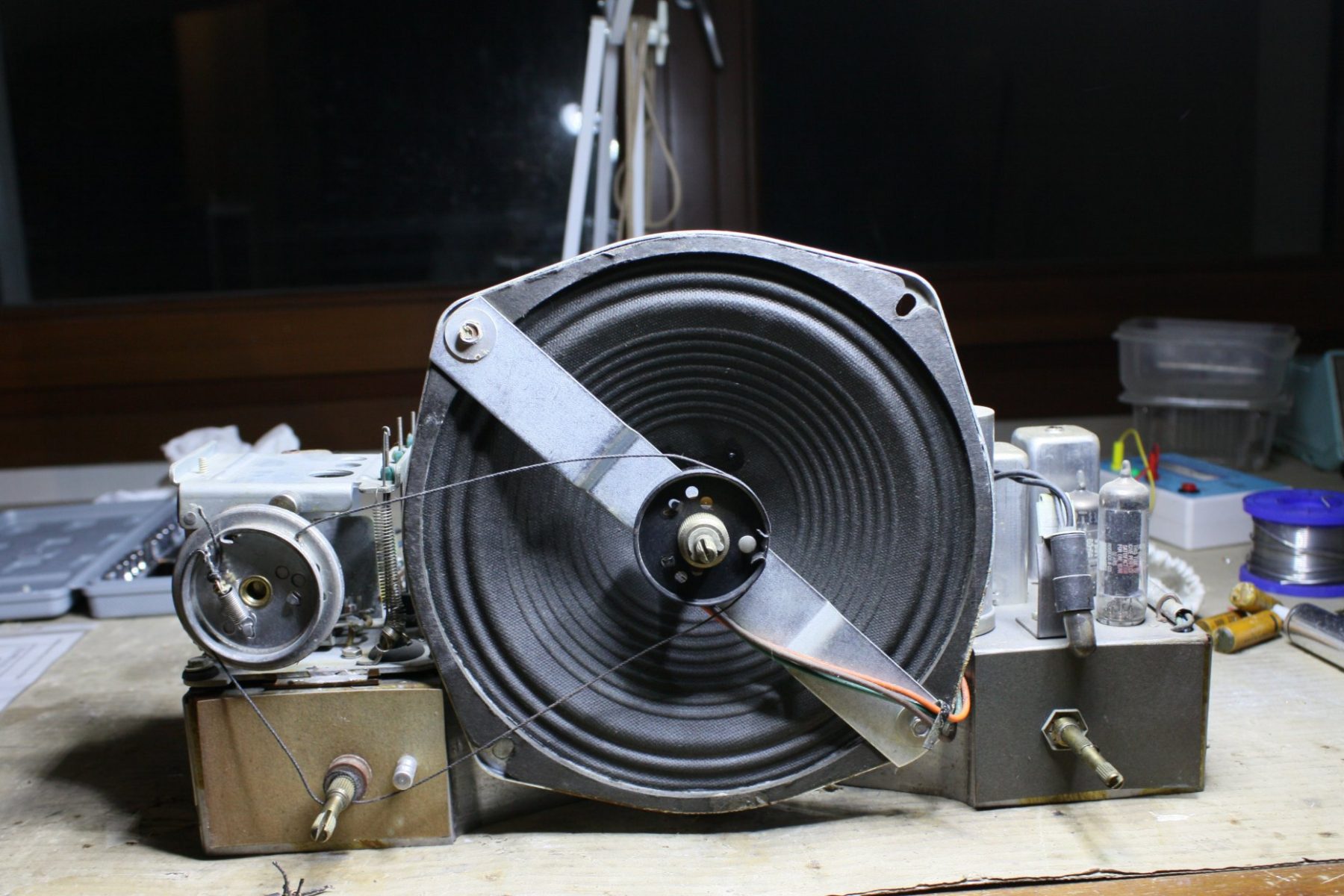








 uncategorised - en
uncategorised - en
 uncategorised - en
uncategorised - en










Dalla seconda guerra mondiale fino agli anni Sessanta, Graetz è stato considerato uno dei più prestigiosi produttori di radio, anche se non ha mai raggiunto performance di vendita elevati a causa del costo elevato e delle condizioni economiche dell'Europa in quell'epoca.
Gli apparecchi Graetz sono sempre stati apprezzati sia per la loro finitura curata ed elegante ma soprattutto, per la ricerca costante di soluzioni acustiche innovative ed i relativi brevetti.
La serie Sinfonia è la più prestigiosa tra produzione Graetz con stadio finale in classe A.
Tra queste la SINFONIA 522 è l'ultima dotata di Raumklang mit Schallkompressor (Surround sonoro con Compressore). I modelli successivi, certamente per questioni economiche, verranno privati di questo geniale, ma costoso, sistema di diffusione del suono.
Lo Schallkompressor verrà descritto approfonditamente più avanti, nella pagina, basti dire per ora che alcuni altoparlanti diffondevano il suono attraverso un percorso appositamente progettato che rendeva impossibile localizzare esattamente da dove arrivasse il suono, rendendo l'ascolto esattamente identico in tutti i punti di una stanza.
I toni medio-alti si diffondono in tutte le direzioni attraverso la griglia, che sembra una semplice decorazione, posta nel lato superiore del mobile.
L'effetto che ne deriva è entusiasmante, una dolcezza dei toni acuti derivante dal tweeter a cono anteriore, unita ad una profondità del basso provocata dai muscoli dei due grossi woofer, con una ampiezza dell'immagine sonora, derivante dal supertweeter compresso a flauto, che non ha eguali in apparecchi monofonici.
Non parlo di alta fedeltà naturalmente, ma di gradevolissimo rapimento sonoro.
La Graetz aveva 4 linee di apparecchi con ShallKompressor:
- la Musica (la più piccola, 1 woofer, 1 mid, 1 tweeter)
- la Melodia (la media, 2 woofer, 1 mid, 1 tweeter)
- la Sinfonia (la grossa, 2 woofer + grandi, 1 mid ellittico, 1 tweeter + grande)
- la Fantasia (come la Sinfonia ma con finali 2 EL95 al posto di una EL84)
Grandi radio, dal suono piacevolissimo, da ascoltare per ore.
Questo è l'apparecchio con Compressore Sonoro esteticamente più bello prodotto dalla Graetz nel 1958
- Banda di Frequenza FM allargata a 88 - 108 MHz. Le radio a valvole prodotte in Germania negli anni 50/60 sono famose in tutto il mondo per la loro eccellente sonorità, la bellezza delle loro finiture, la robustezza ed il loro standard di costruzione senza compromessi.
Purtroppo la banda FM di estende dai 87.5 ai 100 MHz per cui ricevono solo alcune stazioni.
Dopo attenti studi ed un gran numero di provesiamo stati in grado di allargare la banda ricevibile da 88 a 108 MHz.
Naturalmente abbiamo dovuto ricostruire anche la scala parlante, identica all'originale, fatta con gli stessi materiali e le stesse tecniche, ma con il nuovo intervallo di frequenza.
Il risultato è perfetto. Un apparecchio originale ma con la possibilità di ascoltare qualsiasi stazione in qualsiasi parte del mondo.
– Ricevitore Bluetooth integrato – Questa unità può essere equipaggiata con un ricevitore BLUETOOTH alimentato direttamente dall'apparecchio Questo rende possibile usare l'amplificatore da qualsiasi dispositivo digitale esterno, come IPAD, Smartphone, o sofisticate stazioni multimediali. Potrete ascoltare le vostre Stazioni Web o le vostre musiche preferite senza cavi in giro per la stanza. Su richiesta è possibile anche montare un Ricevitore Wireless.
– Connessione Multi-Piattaforma – L'apparecchio viene fornito di un cavo di adattamento che permette di collegarlo a qualsiasi dispositivo digitale come A Iphone, Smartphone, Laptop, CD Player etc. Questo cavo speciale permette di adattare l'impedenza tra l'apparecchio ed i moderni dispositivi. Inoltre i due canali stereofonici vengono fatti confluire in un unico canale monofonico senza incrementare il carico dell'unità sorgente.


La Ehrich & Graetz AG fu fondata nel 1866 a Berlino da Albert Graetz (1831-1901) e dal commerciante Emil Ehrich (morto nel 1887) con il nome di "Lampen-Fabrik Ehrich & Graetz OHG" (E & G).
PetromaxNel 1897 l'azienda passa sotto il controllo dei figli di Albert, Max Graetz, e Adolf Graetz. L'azienda cresce rapidamente, e nel 1899 vengono costruiti nuovi complessi industriali a Berlino, negli Stati Uniti, Francia, Regno Unito, e Bombay.
Intorno 1910-1916 Max Graetz sviluppa la famosa lanterna Petromax. Intorno al 1925 la fabbrica produce anche radio e altri apparecchi elettrici chiamati Graetzor.
Altena Graetz FactoryDurante la seconda guerra mondiale, proprio come nella prima guerra mondiale, la società fa parte dell'industria bellica. Con l'uso di lavoratori forzati da Francia, Russia, e nei Paesi Bassi la società fa enormi guadagni.
Alla fine del mese di aprile 1945 la fabbrica viene rivendicato dall'esercito russo.
Nel 1949 l'azienda entra a far parte del programma del "Popolo", "VEB-VolksEigenerBetrieb" e dal 1950 "VEB Fernmeldewerk, Berlin Treptow (RFT)." VolksEigenerBetrieb, significa che la fabbrica era di proprietà del popolo per il popolo.
Nel 1948 Erich, e Fritz Graetz fonda una nuova società a Altena, in Germania nota con il nome Graetz, come successione della azienda di famiglia persa a Berlino. La nuova società produce principalmente radio e TV.
Nel 1961 l'azienda viene poi venduta a standard Elektrik Lorenz (SEL) AG, e dal 1987 è di proprietà della società finlandese Nokia.
Anno di produzione: 1957/59
Supereterodina IF: 468/10700
8 Circuiti AM - 13 Circuiti FM
Gamme d'onda: Onde Medie (OM), Onde Lunghe (OL), Onde Corte (OC), FM (UKW)
Altoparlanti:
2 largabanda ellittici
1 mid/tweeter
1 tweeter a tromba con flauti
Dimensioni (LHP) : 680 x 400 x 305 mm / 26.8 x 15.7 x 12 inch
Peso netto: 16 kg / 35.242 lb
Valvole 7: ECC85, ECH81, 2xEF89, EABC80, EL84, EM34
Antenna rotante in ferrite per AM


Nella naturale evoluzione del modello Sinfonia alla Graetz hanno iniziato ad usare altoparlanti a tromba.
Gli altoparlanti a tromba hanno il vantaggio di avere una membrana molto piccola e leggera. Questo si traduce in una capacità di raggiungere frequenze molto elevate con una ridottissima distorsione.
Come tutti gli strumenti musicali questo tipo di altoparlanti è composto da generatore del suono e da un risonatore. In un violino le corde vibrando emettono il suono, ma è la cassa armonica che lo amplifica e lo colora.
Negli altoparlanti a tromba la piccola e leggerissima membrana vibra e poi la tromba amplifica, e talvolta modifica, il suono.
La tromba ha lo svantaggio di essere fortemente direttiva. A pochi cm dal suo asse l'intensità del suono cambia notevolmente. Il sistema a tromba, pur essendo molto efficiente e con bassa distorsione non è adatto
Gli ingegneri Graetz hanno preferire una tubazione accordata invece della tromba per le caratteristiche di maggiore direzionalità.
La pressione dell'onda sonora via con il quadrato del rapporto tra diametro e lunghezza del tubo. Per questo motivo alla Graetz parlano di compressore sonoro.
Quindi dalla piccola emissione della membrana del cono si ottiene una grande radiazione sonora all'uscita dei tubi.
Inoltre poichè il rapporto tra lunghezza e diametro del tubo è molto grande si ottiene una propagazione simile alla propagazione su un condotto di lunghezza infinita. Le fessure di uscite sono poste a distanze diverse per ottenere questo effetto di assenza di risonanza. Lo schema equivalente è quello di un ciruito LC dove i fori si comportano come induttanze.
Il risultato di questa caratteristica, unita alla particolare forma e posizione delle fessure di uscita del suono è che la frequenza di risonanza è attorno ai 12 kHz e questo sistema viene fatto lavorare nella fascia che va dai 700 Hz ai 10 kHz, proprio dove si ha la massima sensibilità dell'orecchio umano, e dove si colloca la voce e la quasi totalità degli strumenti musicali.
Oltre ai vantaggi di assenza di distorsione e di efficienza la assenza di risonanze ha come risultato una notevole morbidezza di ascolto.
Da ultimo questo condotto produce un lieve ritardo, di pochi ms che inducendo un minimo riverbero naturale ottiene come effetto finale quella profondità scenica che rende questo apparecchio incredibilmente appagante all'ascolto, pur essendo monofonico.
Come già detto in precedenza Schallkompressor significa Surround sonoro con Compressore.
Faccio notare che questa azienda applicava questi concetti e queste soluzioni (surround, compressione del suono) alle apparecchiature commerciali, e siamo nel 1958.
Come ormai oggi sanno tutti le note basse per loro natura si diffondono in maniera omnidirezionale nell'ambiente, per cui è piuttosto difficile localizzare un subwoofer ad occhi chiusi.
Gli altoparlanti che diffondono le note acute invece sono estremamente direttivi per cui il loro posizionamento rispetto alla posizione d'ascolto è molto critica, per cui basta spostarsi un poco dalla posizione d'ascolto prevista per perdere parte del messaggio e del dettaglio della parte più alta dell'informazione sonora.
Questo problema è stato affrontato nell'evoluzione degli impianti Hi-Fi con i sistemi più diversi.
La Graetz lo risolse all'epoca in maniera estremamente efficace con il sistema 4R nei modelli Sinfonia precedenti e Schallkompressor nei modelli dalla 422 in poi.


Il sistema di controllo dei toni è molto efficiente. Sopra le grandi manopole dei controlli di tono troviamo una banda che si illumina progressivamente indicando l'enfasi data alla banda su cui agisce.


Premendo uno qualsiasi dei tasti del gruppo Klangregister i controlli di tono vengono esclusi perchè vengono esaltate le frequenze previste dal tasto scelto.
Per questo motivo anche le luci che illuminavano la scala indicante la posizione dei controlli di tono vengono spente.
Si riaccenderanno premendo il tasto Raumklang e tornando quindi alla determinazione manuale della curva di risposta preferita.






Tre tasti sono raccolti nel gruppo Abschaltung (Disattivazione) e sono rispettivamente:
Aussen-L(autsprecher) - Altoparlante esterno
Mag(isches)-Auge - Occhio magico
Raumklang - Registri musicali predefiniti
Tre tasti sono raccolti anche nel gruppo Klangregister (Registro musicale), questi sono molto intuitivi e sono rispettivamente:
Sprache - Voce
Solo - Solo
Orchester - Orchestra
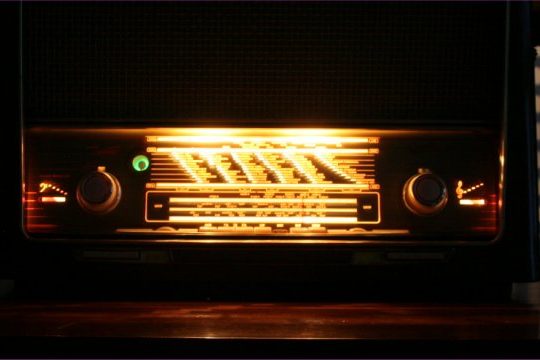

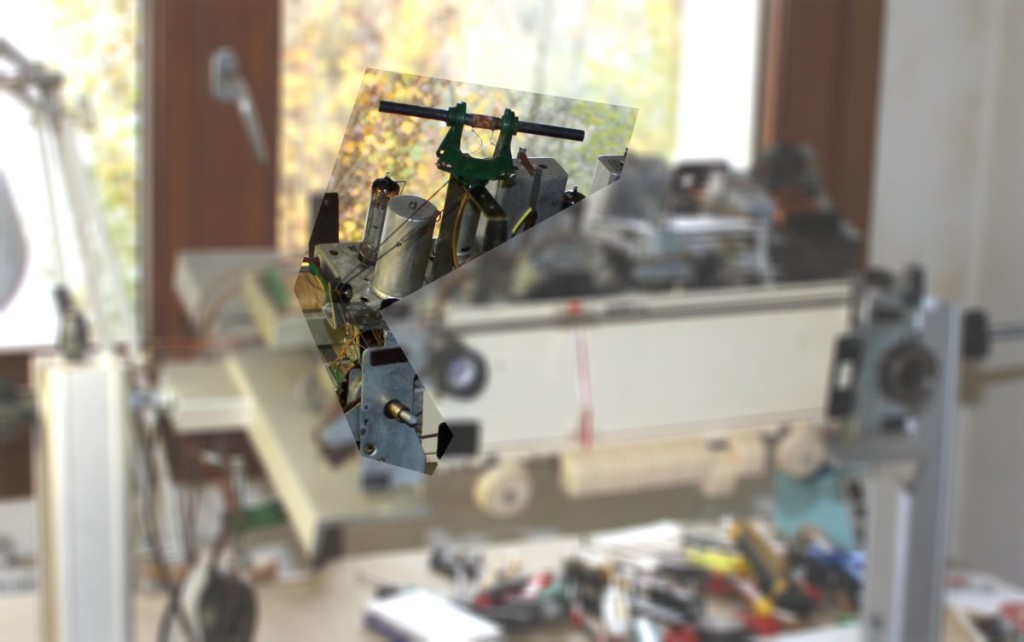
Antenna in ferrite rotante con finestra che ne indica la posizione.
L'antenna in ferrite si ruota con la manopola grande dietro alla manopola del volume,
All'interno del mobile è presente un dipolo per la ricezione FM ed una antenna in ferrite orientabile per la ricezione AM.
La sensibilità in ricezione con le antenne interne è molto buona.
Il sistema di sintonia è un'altro gioiello.
L'apparecchio è dotato di meccanismi di sintonia separati per le bande AM e per quella di ciascuna delle due bande FM.
La manopola della sintonia è una sola ma un selettore commuta su sistemi di cavi (tutti di acciaio) e pulegge separati a seconda della banda.


L'occhio magico ovviamente è stato sostituito.

A sinistra si trova il comando del volume (con loudness incorporato) ed assialmente a questo il comando di rotazione dell'antenna in ferrite.
Si vede l'indicatore della posizione dell'antenna.
L'occhio magico che indica la perfetta sintonizzazione di ciascuna stazione.
La scala AM per le Onde Lunghe, Medie, Corte e la scala FM.
Sotto da sinistra troviamo nell'ordine la manopola del controllo dei bassi, i tasti di accensione, giradischi, registratore, i tasti per sintonizzarsi sulle Onde Lunghe, Medie, Corte, FM, la manopola del controllo degli acuti.
Sotto ogni tasto è indicata la banda di frequenza interessata.
Vi è infine la manopola della sintonia, il cui movimento è molto piacevole essendo supportata da un grosso volano.
Sotto ancora troviamo le due grosse manopole del controllo dei bassi e degli alti.
Assialmente alla manopola di sintonia si trova un selettore per il controllo della selettività in AM.
I registri ed i tasti di esclusione sono stati visti precedentemente nei particolari.

Uscita per altoparlanti esterni.
Presa per registratore (tonbandgerat).
Ingresso giradischi (tonabnehmer)
Ingressi antenna AM ed FM e presa di terra.



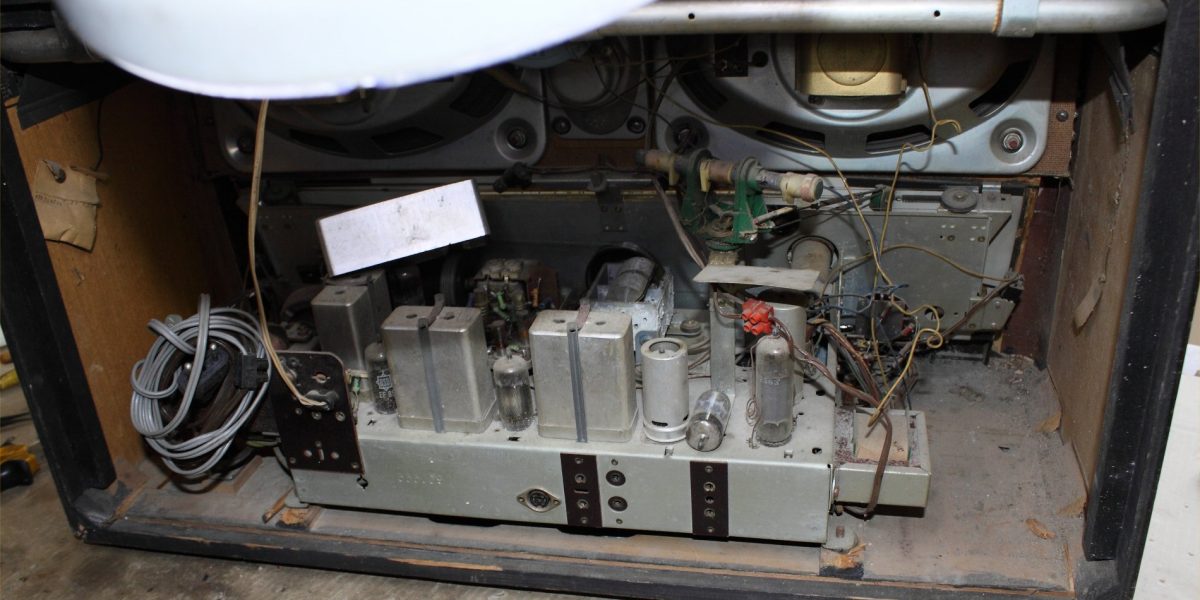



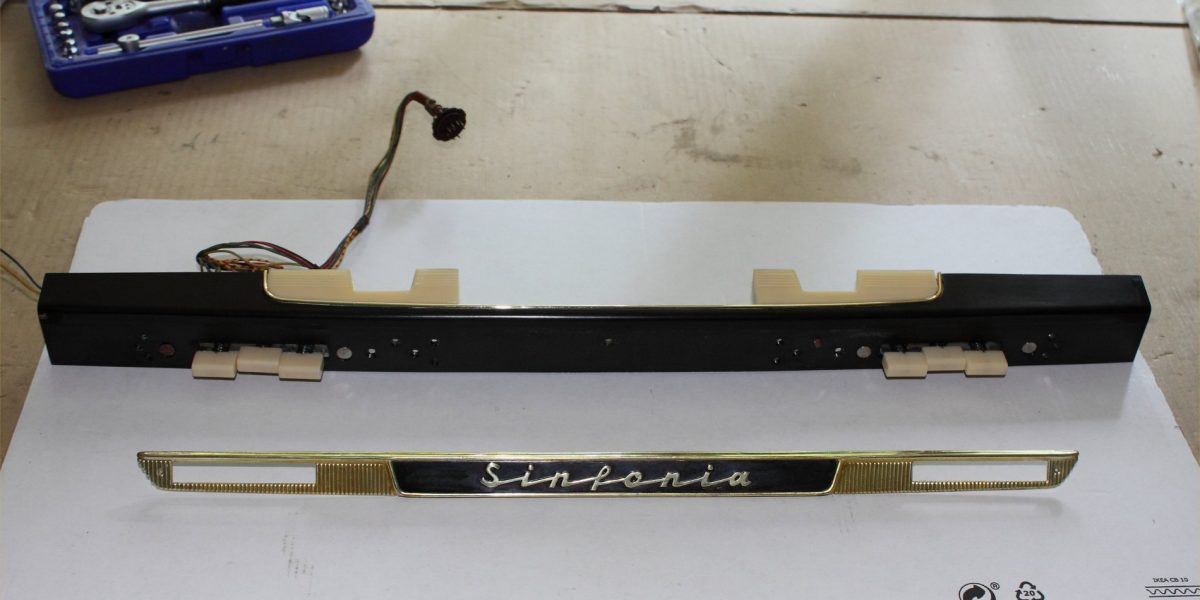


 german radios - en
german radios - en
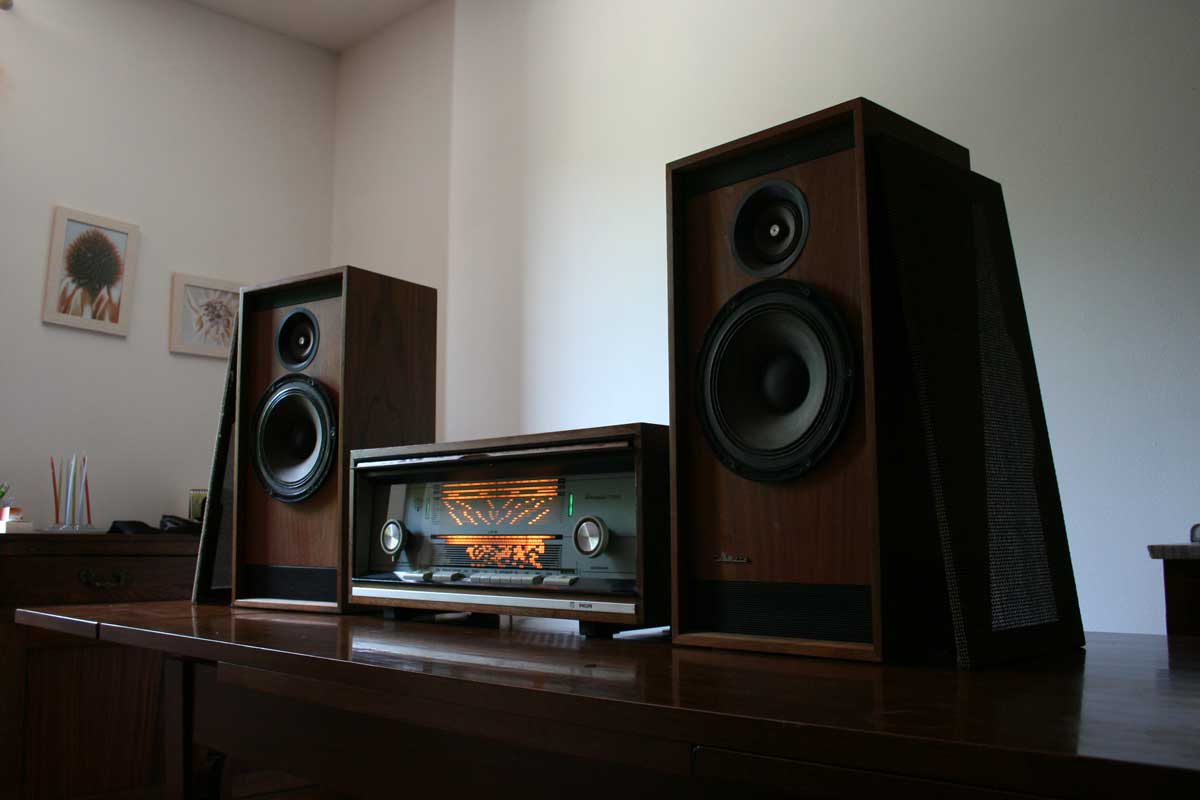




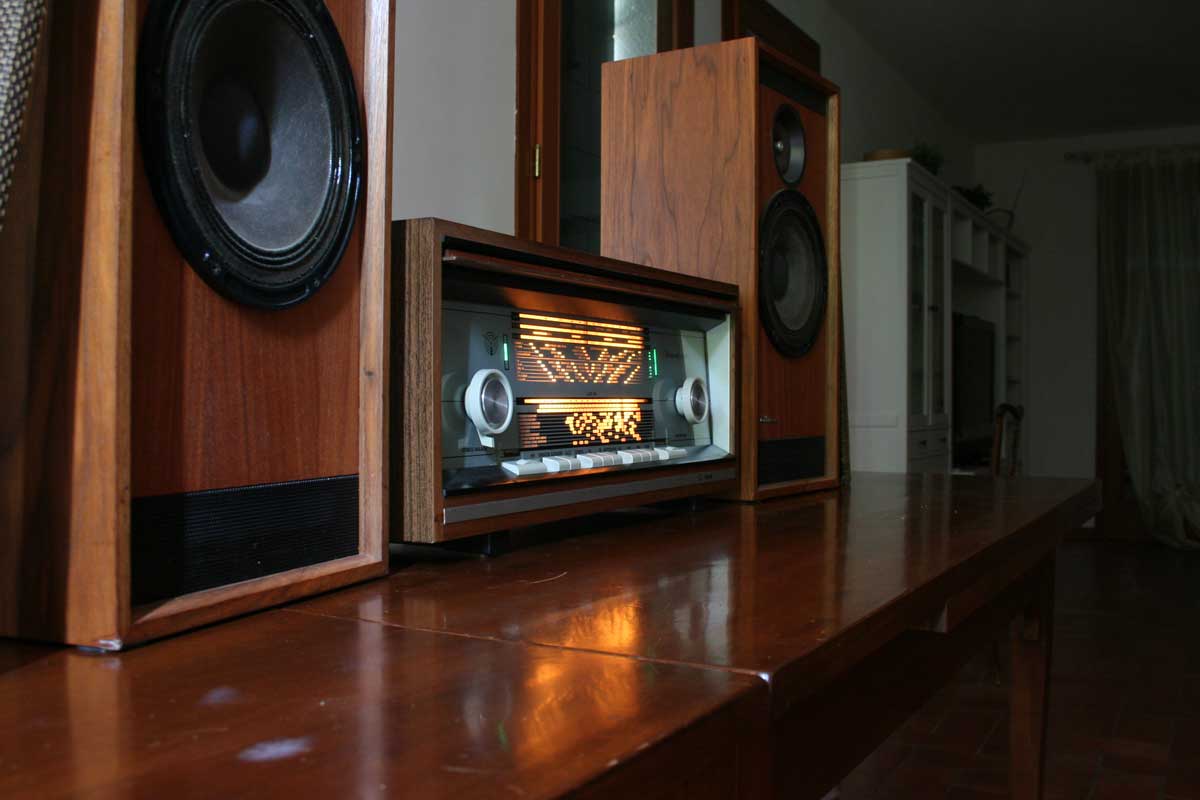


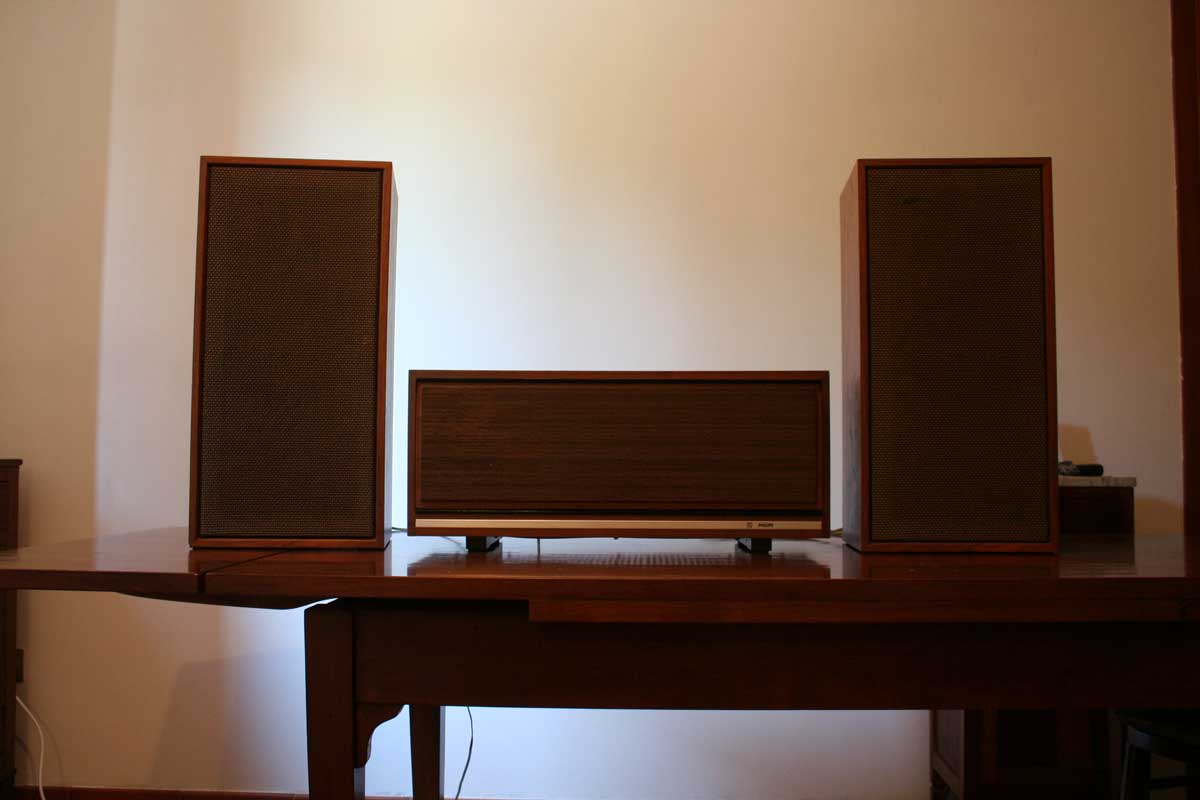

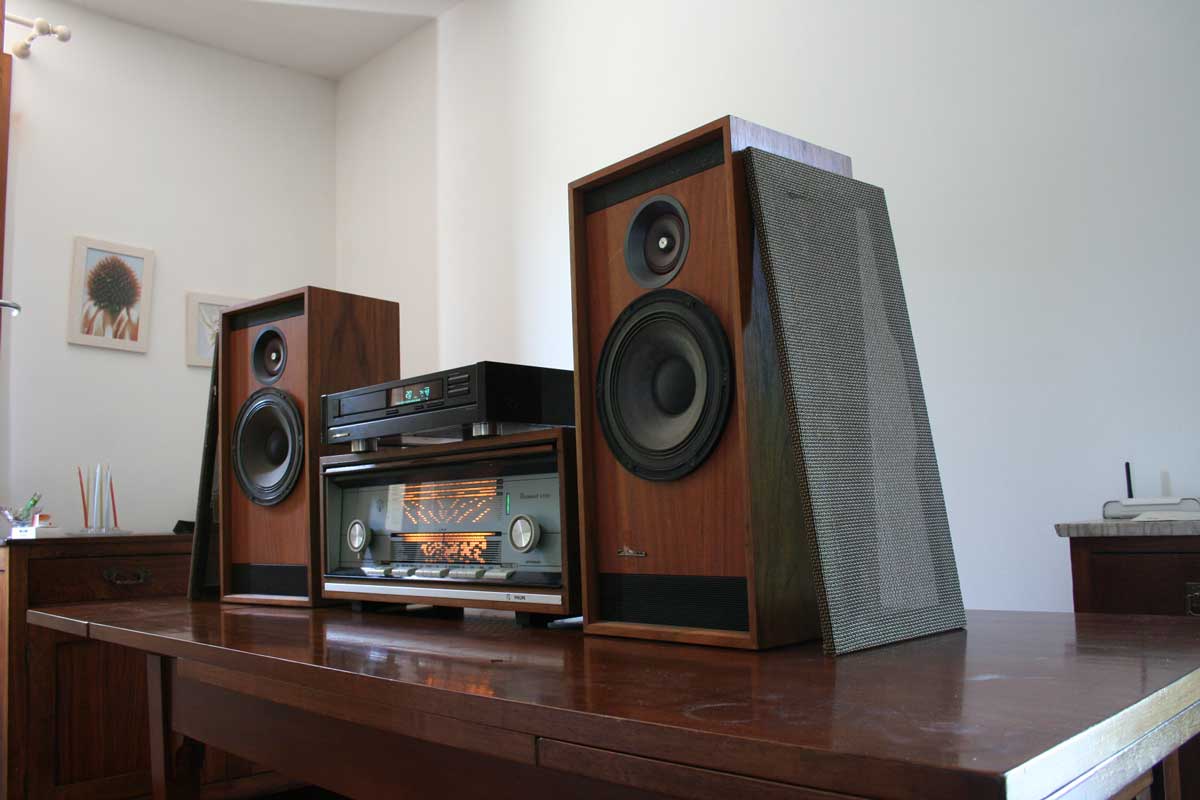
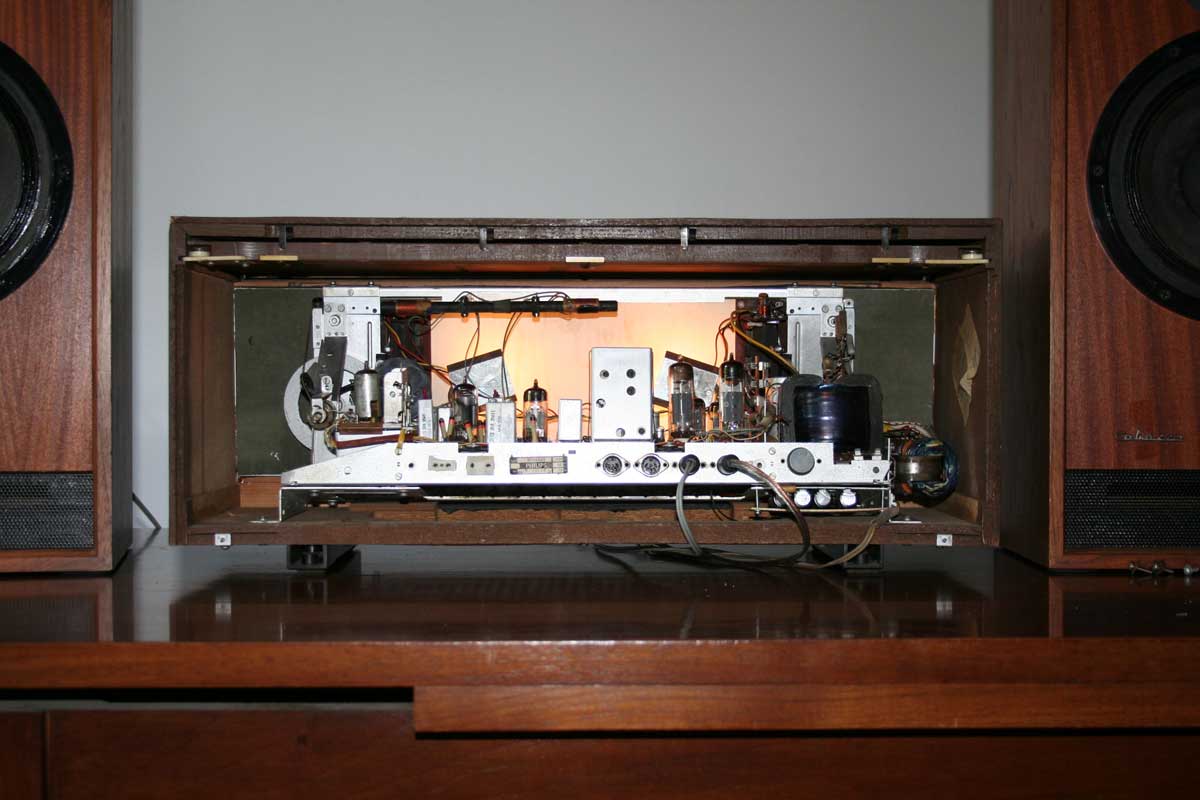

Philips products in Italy have always been a little ignored in the HI-FI world: they were linked to the other thousands of low technological content products, appliances, consumer products and so on that this producer has made through the years.

Nothing more wrong and superficial.
Philips is a manufacturer with a huge know-how. One of the best tuners in the world comes from them, the AH673.
One of the most broadband speakers in the world the AD9710 comes from them.
Even the invention of the compact cassette and then of the Cds comes from them.
They made maybe the best CD mechanism in the world, the CDM1, the first DVD recorder, the technology of the devices produced from a certain date with the Grundig, Marantz, B&O and other marks.
So, who snubs Philips does it for lack of knowledge.
Presented the manufacturer, let's talk now about the machine.
In greek mithology, Uranus god of the sky, Gaia's husband, threw his children in the bowels of the earth as long as they born to avoid their supremacy. Gaia, horrified, made for her 12th son, the titan Cronus, the adamantine sickle. Cronus evirated Uranus and from his genitals thrown in the sea was born Aphrodite.
Probably in the choice of the name at the Philips headquarters refered to the magnitude of the divinity, but it's a fact that the Uranus Tonmeister B7D52AS is one of the best tube receivers ever made by this manufacturer.
Built to compete with Telefunken Opus, Nordmende 3004, Grundig Stereomeister, owes the second part of its name “Tonmeister – Master of Sound” surely to the care it has been studied with, in any detail.
The output stages are made of couples of pentodes in Push-Pull with Voltage Negative Feedback without frequency correction. In this way it is ensured the maximum linearity with the less compression effect possible, undesireable effect typical of the Negative Feedback circuits. Other manufacturers made other choices and this determines the different personality of these devices.
The Philips by this point of view distinguishes for its timbre neutrality.
The pre-amplifier stage is provided with many equalization possibilities but I prefere to listen excluding them: I don't feel the necessity with these loudspeakers there's no acoustic deformation to correct.
The radio-frequency stage is of a very high level and classical setting provided with excludable AFC. Interesting the typical little IF transformers, difficult to de-tare and insensitive to fashes.
Even in this case I matched for this try-out the Uranus with its cousin Marantz CD94 MKII, wonderful machine with CDM1 component and a pair of TDA1541A in antiphase, one of the best existing machines, and to a pair of Cabasse Dinghy 222, high efficiency speakers described later.
The stations stay perfectly stable thanks to the AFC, so the listening of the tuner is very relaxing. The listening from the CD or other sources is timbrically very balanced.
Listening from an Ipod is possible and comfortable.
Even in this case its an authentic vintage Hi-Fi System with no compromises, for those who know exactly what they are buying.
The device is equipped with the rare Stereo Decoder, allowing you to listen to a multitude of FM Stereo broadcasts in stereo
It is possible to connect any speaker, preferably with high efficiency.
Built-in Bluetooth receiver
Each radio is equipped with a special cable that connects with any digital source.
- Separate loudspeakers - Using separate loudspeakers is an important option for stereo receivers. This allows you to couple the receiver to speakers best suited to particular space, design or acoustic performance requirements. The most suitable loudspeakers are analysed later, under loudspeakers.
- Stereo Decoder - The device has an integrated Stereo Decoder. This allows you to listen to stations that use this transmissions system in stereo. Many stereo receivers are not equipped with a Multiplexer so they work in stereo only when you select the record player’s /Recorder/Aux input . Such receivers, in listening to the radio, send the same signal to both channels, so listening is monaural. This is not the case with the Concertino 2380, which is totally beyond stereo.
- Built-in Bluetooth receiver - This unit can be equipped with a BLUETOOTH receiver powered directly from the device. That makes it possible to use the amplifier from any digital device, IPAD, Smartphone, or sophisticated multimedia station. You can listen to your wireless Web Stations or favorite music around the room. On request, we can also mount a Wireless Receiver.
- Multi Platform connections - Along with the device, we can also provides you an impedance adapter cable to connect any digital source, such as iphone, smartphone, computer, CD player, etc. This purpose-built cable adapts different impedances of modern digital equipment. Also the two stereo channels are collected into a single flow without increasing the load input unit.
In 1891, the brothers Gerard and Anton Philips, started to produce the first incandescent bulbs in Eindhoven.
Later, Philips specialized in the production of electro- medical equipment, and in 1918 introduced the first X-ray tube.
In the following years, Philips began specializing in the broadcasting industry. In 1932 the company succeeded in selling over one million radio equipment and became the world’s first producer.
During the Second World War, Philips transferred to the Netherlands Antilles, and returned to the Netherlands at the end of the conflict.
In the second post- war period, began the production of the first televisions, then the launch of the music cassettes in 1963 and the production of the first integrated circuit in 1965.
In 1982 Philips launched with Sony the first compact disc player.
In 1984 Philips acquired the control of the German Grundig.
In the 90's Philips faced a financial crisis.
In 1991 it inserted on the market the Video CD and it is one of the first companies in the world to develop high definition television.
In 1999 Philips established a joint venture with LG Electronics, named LG Display, which ends in 2009.
In 2006 together with Sony launched the first Blu-ray.
In 2009 Phillips launched the first full-HD LCD TV in 21:9 format.
Phillips holds 48,000 registered patents.
Currently, the production is focused on low- energy lighting products and LED systems and services for diagnostics and production of medical devices.
Year of production: 1966/67
8 Circuiti AM
12 Circuiti FM
Wavebands:: LW, MW, SW, FM
Operating voltage (CA): 110; 125; 220; 240 Volts
Mobile in legno con frontale chiudibile
Dimensions (LHP): 562 x 195 x 280 mm / 22.1 x 7.7 x 11 inch
Net weight: 13 kg / 28 lb 10.1 oz (28.634 lb)
Potenza d'uscita: 8 + 8 W
11 Valvole: ECC85 ECH81 EF89 EBF89 EM84 ECC83 ECC83 EC92 EC92 ELL80 ELL80
Rotating ferrite aerial for AM bands


The output stage has been already briefly described in the introduction of the machine, its a clasic Push-Pull in AB class that produces an 8W power per channel.
The interesting fact is the load resistence that excludes automatically when the speakers' jacks are plugged in, avoiding the overload of the final stadium in case of powering it up without speakers connected.
The device is equipped with two aerials. A ferrite for AM ranges and a wire loaded for the FM range.
Listening to AM was already considered unimportant at the time, outlined by FM features.


The correction system of the frequency response, quite antiquate command in such a machine but at the top those years, is made of three buttons that instert three pre-defined equalization curves.
I prefere to listen with the “Jazz” button switched.
The tone control system is very efficient. Above the large tone control knobs there is a band that lights up gradually indicating the emphasis on the band on which it acts.







The unit is equipped with mechanisms for keeping separate the AM and FM bands.
The movement is transferred to both mechanisms with a system of pulleys and separated gears.

The Automatik button is the one of the AFC that permits to maintain always perfectly tuned a station once tuned in.
That is not to be used during the research of the station, otherwise the receiver would concentrate only on the most powerful stations.
Once tuned-in the prefered station pressing this button the receiver will correct automatically possible frequency skiddings, keeping always perfectly tuned.
Coaxially, we find the balance knob.
The magic eye that indicates the presence of a stereo station.
Going on, we find the AM scale for the Long, medium, and short waves and the FM scale.
Furher on the right we find the tuning knob.
The magic eye that indicates the perfect tuning of each station.
Below we find in the order: bass controls, on and off buttons, the three EQ buttons, the mono/stereo button, and the selection of the inputs buttons (Turntable, Recorder/CD, AFC, long medium short waves, FM)
We find in the end the treble control.

I used the Dinghy 221 and 222, prefering the last ones even if more expensive, because they keep almost every feature of the single-driver (the woofer is cut at 5000 Hz) with an extension, on the tops and on the lows that the 221 can only dream.
Because of the crossover the efficiency is lower than 2db but still remains very high, settling at 96db.
This feature allows the Telefunken to be used normally at a fraction of its real power, for the benefit of linearity.
The Dinghy sound very fast despite the appearence, the string instruments come out of the speakers with an effortlessness that makes them get close to the Open Baffle.
The loudspeakers are of very high quality, made on Cabasse detailed bill.
The cabinet is well finished and its dimensions are incredibly limited for the performance they offer.
The material published is taken from the very interesting trans-apline forum dedicated to this prestigious brand: vedi
AM and FM antenna inputs and ground socket.
Output for external speakers.
Socket for recorder (tonbandgerat).
Turntable input (Tonabnehmer)



